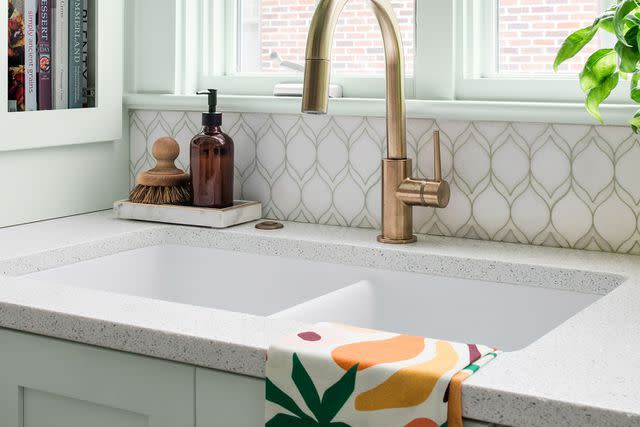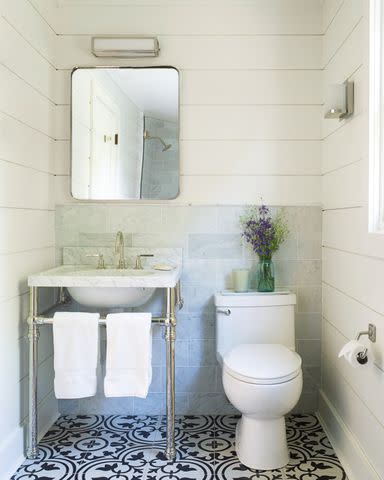9 Things You Didn't Know You Could Clean with a Scouring Stick
This compact cleaning tool can be used around the entire house.
You might already have a scouring stick stored with your cleaning supplies but if you don't, consider adding a few to your arsenal. Sometimes referred to as pumice stones (similar to the kind used during a pedicure), scouring sticks are small, non-toxic, and inexpensive. And they’re incredibly handy to have around the house as they work well to get grime out of numerous surfaces.
The small sticks usually cost just a few dollars and can be used for a wide variety of spaces in your home. Use them to clean your shower, your oven, and even your grill! These are the spots around the house you can safely clean with a scouring stick—and a few to avoid.

Robert Peterson
Related: 10 Essential Cleaning Tools to Keep Your Home Sparkling
Scouring Stick Safety
Before you start scrubbing, take note that there are certain materials that you should avoid using a scouring stick on to preserve their integrity. Avoid using them on enamel, acrylic, plastic, stainless steel, decorative tile, and any kind of kitchen countertops, regardless of if they’re made of granite, marble, Corian, or butcher block. You’ll most likely want to steer clear of all wood surfaces, especially if they’re painted, as the scouring stick can remove layers of paint. (Although, if you accidentally spill paint on a surface, you may be able to remove it with a scouring stick!) Most glass, including fiberglass, is also off limits but note that tempered glass is permissible.
Another important thing to remember is that scouring sticks should always be wet before you start cleaning with them. If you’re unsure of whether it may be too harsh on a particular surface, always test it on an inconspicuous spot first.

Things You Can Clean with a Scouring Stick
1. Toilet Bowls
Get rid of toilet rings instantly with a scouring stick. First, empty and clean the toilet bowl like you normally would. Then, scrub any leftover stains with the stick directly. We recommend using a scouring stick with a handle so you can stay at a comfortable distance while cleaning the toilet. The pumice won’t scrape the porcelain, but will do a solid job of removing stains and hard water or mineral buildup.
While you can run scouring sticks under water and let them air dry before storing them away, you’ll want to reserve one stick to be used for toilets (and toilets only) for sanitary reasons.
Related: The 11 Best Toilet Bowl Cleaners of 2023 That Are Fast-Acting and Effective
2. Showers and Bathtubs
As long as they’re made of the appropriate material, take to your shower or tub with a new and damp scouring stick. Gently scrub the surfaces to rid of any tough stains so they sparkle like new. These tiny tools are also ideal for cleaning grout and hard to reach areas, such as near sliding glass doors.
Related: How to Clean a Shower So It Sparkles from Top to Bottom
3. Sinks, Faucets, and Drains
While you're cleaning the bathroom, take a minute get your sink and all its components clean with a scouring scrub. As with both toilets and tubs, you should be able to get stubborn stains out of the sink itself and then use the scouring stick to buff away those unsightly mineral deposits that form around the faucet and drain.
Go ahead and repeat the process to clean the kitchen sink, given the material it’s made of is appropriate. Stainless steel or copper sinks, for example, should not be touched with anything abrasive, such as a scouring stick.
Related: How to Clean a Bathroom Sink and Keep It Looking Pristine
4. Ovens
Baked-on grease and grime won’t stand a chance against a scouring stick. Soak oven racks in soapy water overnight and then scrub them to get the remaining residue off in the morning. While the racks are drying, you can clean the inside of the oven as you normally would and use the scouring stick for persistent bits of food or carbon build-up.
Also consider cleaning your cast iron cookware and any tempered glass cookware, such as a casserole dish, with a scouring stick as well. Consider reserving one scouring stick for food-related dishes, so you're not scrubbing the family casserole dish with the same stick you used on the shower floor.
Related: How to Use the Self-Cleaning Oven Function Correctly
5. Outdoor Grills
If it’s gentle enough for the indoor over racks, a scouring stick is definitely a solid choice for cleaning your outdoor grill grates. First, run a metal brush over the grates, then wet a scouring stick, and scrub any stuck-on barbecue sauce or steak remnants. Wipe it clean with a cloth so it’s good to go for your next backyard bash.
Related: The Best Way to Clean a Grill for Delicious Backyard BBQ
6. Swimming Pools
Pool maintenance can be a hassle—but regular upkeep is imperative so that it stays in swim-worthy condition. Luckily, a scouring stick can not only work on concrete, gunite, plaster, and tile-lined pools, it can also tackle a multitude of messes. You can use one to clean rust, mineral or algae deposits, mildew, and hard water stains.
Related: How to Clean a Pool, Plus Must-Know Maintenance Tips
7. Metal Tools
If you’ve ever left your garden tools exposed to the elements, you know how swiftly they can rust. Thankfully, a scouring stick can help to restore them to like-new condition. Most metal items, like tools or pipes, are durable enough to withstand scrubbing a layer of rust. However, thin metals may scratch if you’re too vigorous with back-and-forth motions.
8. Fabric
Scouring sticks can be used to remove pet hair and lint from fabric furniture, upholstery, and even carpets. It’s particularly effective if the hair tends to settle into fibers and is difficult to remove with a vacuum cleaner. Using soft, swift strokes, brush the hair in one direction and, once it’s collected together in one spot, then vacuum it up effortlessly.
Related: How to Clean Couch Cushions
9. Grout
You can also use a scouring stick to scrub any kind of grout you have in and around your home. Use it to tackle grimy kitchen backsplash grout or to get stains out of flooring grout. Just be sure not to use it on any of the forbidden materials, like enamel or decorative tile.
Related: How to Clean Grout Using Pantry Staples You Probably Already Have
For more Better Homes & Gardens news, make sure to sign up for our newsletter!
Read the original article on Better Homes & Gardens.

